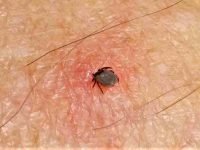This post contains affiliate links. If you click on a link and make a purchase I earn a commission at no extra cost for you.
Ticks are found almost everywhere and the transmission of dangerous diseases through tick bites continues to increase. After mosquitoes, ticks are the second most common disease carrier for humans worldwide. In some areas, every third tick is infected with bacteria that cause Lyme disease. Other diseases spread by ticks are Anaplasmosis, Rocky Mountain Spotted Fever, Ehrlichiosis, etc. Protection against ticks is important for anyone who moves around outdoors. Apart from using lotions and sprays, you can also use tick repellent clothing to repel ticks.
Tick Repellent Clothing
Since ticks typically wait in grass or shrubbery no higher than 3 to 4 feet of the ground, the first contact with a human victim is usually the feet or the legs. Ticks need bare skin to bite, so they crawl around on socks and pants trying to find a way in.
Tick repellent clothing is treated with biocides that cause a “hot foot effect” in ticks and as a result, they simply fall off.
It is usually work clothing, e.g. for gardeners, forest workers, rangers, or uniforms for soldiers. But with the spread of ticks and the increase in tick-borne diseases, tick repelling clothing is becoming increasingly popular.
Tick repellent clothing is an effective and safe method to keep ticks off. Wearing Permethrin-treated clothing allows you to move and work outdoors without permanently worrying about ticks. Read on to find out how the tick repellent clothing is made and how it can be beneficial to you.
Permethrin
Clothing treated with Permethrin is commonly used to protect military personnel as well as outdoor workers.
Permethrin-treated clothing immobilizes and kills ticks and mosquitoes when they get in contact with it. So when a tick finds hold on treated clothing it can only briefly hold on and will fall off as soon as the permethrin acts on the nerves of the bug.
Permethrin is one of the world’s most widely used insecticides. Especially in countries where there is a high risk of malaria, zika, and other mosquito-borne diseases, mosquito nets are regularly treated with permethrin. It is a very effective and simple measure to provide protection.
Factory Treated Tick Repellent Clothing
Abut any type of garment can be treated with Permethrin. Socks, pants, shirts, jackets, etc, are factory-treated and are available in outdoor gear shops or workwear stores.
The active agent permethrin is bound to the fiber using a special process so that it provides effective protection even after several machine washes. However, it will slowly wear off.
Permethrin very slowly breaks down by itself, sunlight speeds the process up a bit. Depending on the concentration that has been used to treat the clothing, protection will last about one year.
Anti-tick Socks
Ticks linger in hiding places low to the ground. Your lower legs or feet are usually the first point of contact with the tick. The tick then starts to crawl upwards in search for a suitable bite site.
Socks are a good first barrier to make life more difficult for ticks. They are effective and cheap.
The only problem is that they are in direct contact with your skin. In rare cases, skin reactions may develop. Obviously then socks are not for you. Some manufacturers have developed special fabrics and application procedures to minimize skin contact.
Permethrin-treated pants
Treated pants are also an effective way to reduce the risk of ticks crawling up and finding a suitable bite site. Permethrin-treated pants also provide good protection against other biting insects such as mosquitos.
Good pants are double-layered, only the fabric of the outer layer is treated thus reducing skin contact with the insecticide.
Forestry workers in many states wear treated clothing to reduce the risk of Lyme disease.
Shirts treated with Permethrin
Shirts treated with insecticides repel mosquitoes and ticks. Nearly half of all mosquito bites are through clothing. So either wearing mosquito-tight fabrics or fabrics treated with insecticides is sensible.
Treated Jackets
Protecting the upper body with permethrin-treated jackets provides another very effective barrier that is near impossible for ticks to overcome. Special attention should be brought to the sleeves as this could be a “way in” for ticks, as one bends down and brushes a leaf where a tick lingers.
Treating Clothing with Permethrin
You can also treat clothing yourself. There are various sprays and preparations on offer. They all contain Permethrin as this is simply the most effective insecticide with the least unwanted side effects.
Permethrin treated clothing side effects
Permethrin is generally considered safe for humans. In rare cases, contact with the skin may cause irritation and itching in rare cases. Discontinue use and seek medical advice.
Do not put treated clothing into the dryer as the heat will remove the Permethrin from the fabrics.
Permethrin is highly toxic to all aquatic organisms. Avoid going into the water wearing treated clothing.
Avoid exposing cats to Permethrin-treated clothing, don’t let them ly on it or lick it. Cats can not metabolize permethrin it can kill them.
Tick Repellent Clothing And Repellents
Wearing clothing treated with permethrin provides effective protection against nasty bloodsuckers. If you are in heavily infested tick territory maybe you want to use topical bug repellents for complete and all-round protection.
If you prefer a more natural approach in warding off ticks you could resort to natural repellents that are based on essential oils. They may not be as effective but they are definitely more friendly to the environment.
Essential oils such as Geraniol, Neem oil, and others can also be applied to clothing to provide a barrier against ticks.



